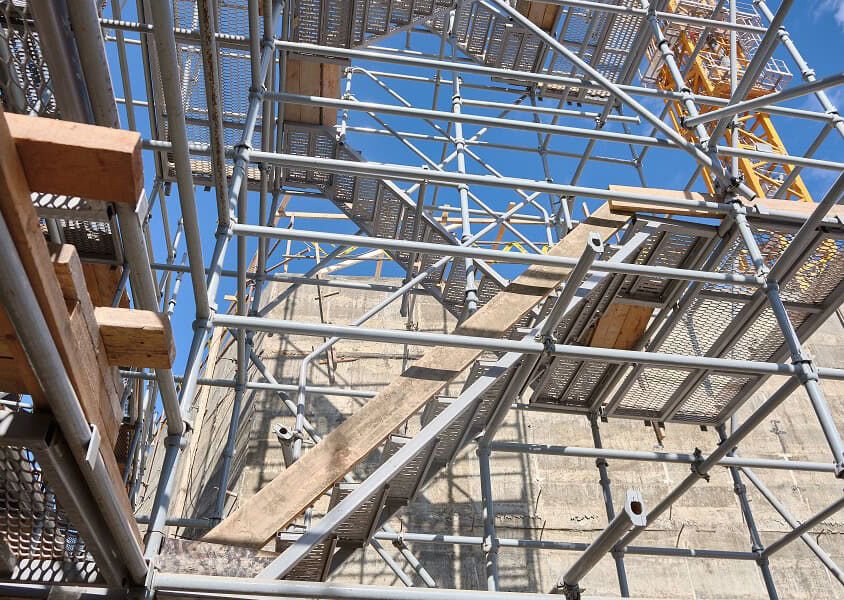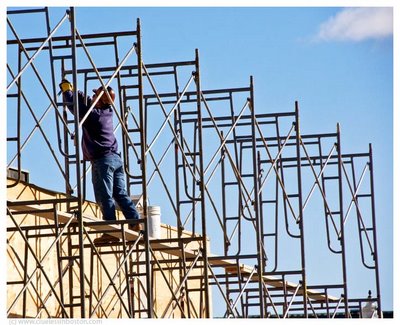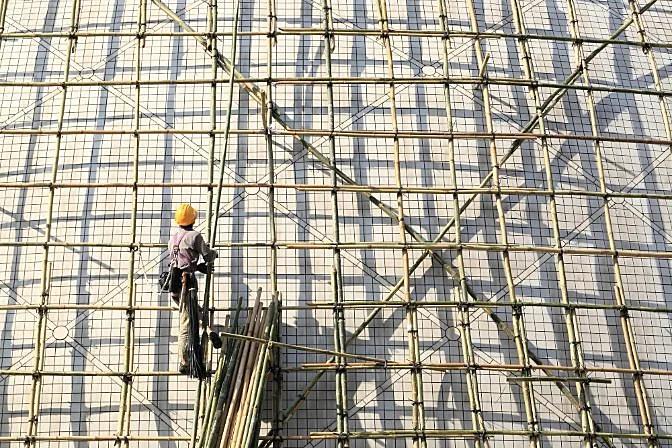Temporary Roof Scaffolding Experts Providing Secure and Reliable Installations
Temporary Roof Scaffolding Experts Providing Secure and Reliable Installations
Blog Article
Exploring the Different Kinds of Scaffolding Used in Building And Construction Projects
The building market relies heavily on numerous types of scaffolding to fulfill particular job demands, each offering distinct advantages and applications. Conventional frame scaffolding supplies a strong structure for basic jobs, while put on hold scaffolding is important for job on high-rise structures.

Traditional Framework Scaffolding
Traditional framework scaffolding is among one of the most widely made use of techniques in the construction industry due to its robustness and versatility. This system is composed of straight and vertical structures that are set up to produce a stable platform for workers and materials. The major elements include upright articles, straight ledgers, and diagonal braces, which with each other supply a strong framework that can sustain considerable lots.
One of the crucial advantages of traditional framework scaffolding is its adaptability to various construction jobs, varying from household buildings to big industrial frameworks. The modular layout permits easy setting up and disassembly, making it effective for both long-term and temporary tasks. Additionally, the system can be customized in elevation and size, accommodating different building styles and website conditions.
Safety and security is paramount in scaffolding applications, and typical frame systems are geared up with guardrails and toe boards to avoid drops and make certain worker protection. Moreover, regular inspections and adherence to safety and security laws are essential in keeping the honesty of the scaffold. Overall, standard framework scaffolding stays an essential choice in the building and construction market, giving a trusted system for labor and boosting overall project effectiveness

Suspended Scaffolding
Suspended scaffolding offers an one-of-a-kind solution for construction tasks that need accessibility to elevated surfaces, particularly in situations where conventional frame scaffolding may be not practical. This kind of scaffolding is typically put on hold from the roofing or upper levels of a structure, utilizing a system of wheels, platforms, and ropes to create a functioning area that can be gotten used to different heights.
Among the primary advantages of put on hold scaffolding is its flexibility. It can be easily repositioned or decreased to fit adjustments in construction demands, making it ideal for tasks such as window installment, frontage work, and upkeep on high-rise buildings. Furthermore, the minimal impact of suspended scaffolding permits far better use ground space in urban settings, where area is typically minimal.
Safety and security is a crucial consideration in making use of put on hold scaffolding. Appropriate rigging and securing systems need to be employed to make certain stability and avoid accidents. Operators has to additionally be learnt the secure usage of this equipment. Generally, put on hold scaffolding supplies a efficient and effective service for accessing hard-to-reach locations in different building and construction circumstances, improving both efficiency and safety and security on site.
System Scaffolding
System scaffolding, often regarded as a modern-day option in the scaffolding market, includes pre-engineered parts that can be find more info rapidly assembled and adjusted for different building tasks. Scaffolding. This sort of scaffolding is defined by its modular style, which enables for adaptability and efficiency on work sites, suiting different heights and structural requirements
Typically made from high-strength steel or light weight aluminum, system scaffolding uses boosted longevity and security. The components consist of vertical blog posts, horizontal journals, and diagonal braces, which interconnect firmly, ensuring a robust structure. The design commonly incorporates standardized installations, streamlining setting up and disassembly processes, thus reducing labor time and expenses.

Rolling Scaffolding
Rolling scaffolding is a flexible alternative to typical set scaffolding, designed for movement and convenience of use on building sites. This kind of scaffolding includes a platform sustained scaffolding in psychology by frames with wheels, allowing workers to easily move it as required. The flexibility function considerably improves efficiency, as it lessens downtime related to putting together and dismantling dealt with scaffolding.
Normally built from lightweight materials such as light weight aluminum or steel, rolling scaffolding uses a strong yet portable service for jobs requiring frequent repositioning - Scaffolding. It is specifically helpful in jobs such as painting, drywall installation, and electric job, where access to various elevations and areas is essential
Security is vital in rolling scaffolding design, with features such as securing wheels to avoid unexpected movement when being used, and guardrails to safeguard workers from drops. In addition, many designs are flexible in elevation, accommodating different project needs.
Cantilever Scaffolding

The layout of cantilever scaffolding normally involves making use of arms or brackets anchored to a structure or structure, enabling the system to prolong external safely. Safety and security is vital; therefore, these scaffolds need to be engineered to hold up against different loads and environmental problems. Normal assessment and upkeep are essential to ensure structural honesty and worker security.
Cantilever scaffolding is favored for its adaptability and efficient use of room, making it a popular selection in metropolitan atmospheres where space restrictions are typical. Moreover, it promotes easier access to high altitudes, ultimately adding to the total performance of construction tasks. As with all scaffolding types, proper training and adherence to security requirements are critical for workers utilizing cantilever scaffolding.
Final Thought
In verdict, the varied kinds of scaffolding made use of in construction projects each offer distinctive purposes tailored to particular site demands. Standard structure scaffolding gives security, while put on hold scaffolding offers adaptability for elevated tasks. System scaffolding facilitates quick assembly, and rolling scaffolding boosts flexibility for differing job settings. Cantilever scaffolding efficiently addresses obstacles in metropolitan settings. Recognizing these scaffolding types is vital for enhancing security and efficiency in building, eventually adding to the effective completion of projects.
Conventional structure scaffolding supplies a durable structure for general jobs, while suspended scaffolding is important for job on high-rise frameworks.Rolling scaffolding is a flexible choice to conventional fixed scaffolding, designed for flexibility and simplicity of usage on construction sites. As with all scaffolding kinds, proper training and adherence to security requirements are crucial for employees utilizing cantilever scaffolding.
Standard framework scaffolding supplies security, you could try here while put on hold scaffolding uses versatility for raised jobs. System scaffolding facilitates quick assembly, and rolling scaffolding boosts wheelchair for varying work atmospheres.
Report this page